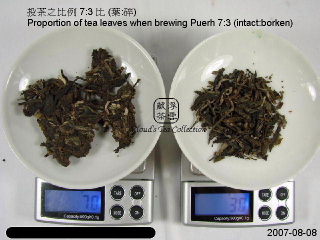 When you want to have a cup of good tea, one of the most important elements should be
your good mood. Without it, it will be hard for you to feel the essence of the tea
no matter how expensive your tea is. Certainly, a good brewing technique is
also one of the essential elements for making a cup of good Chinese tea. If you
brew tea inappropriately, the tea broth can be nasty.
When you want to have a cup of good tea, one of the most important elements should be
your good mood. Without it, it will be hard for you to feel the essence of the tea
no matter how expensive your tea is. Certainly, a good brewing technique is
also one of the essential elements for making a cup of good Chinese tea. If you
brew tea inappropriately, the tea broth can be nasty.You might have an experience that the sample tea you tasted in the tea shop was outstanding. However, you could not brew that wonderful taste again at home after you had bought some for your own consumption. Usually, people would blame the tea shop in the first place.
In fact, the right question to be asked is that whether you are brewing the tea with a good method or not. Without knowing the nature of tea, you might not perform a tea well. Therefore, Cloud would advise you that you may consider to brew the compressed tea in a teapot with an appropriate ratio of intact tea leaves to broken tea leaves.
It is true that broken tea leaves are essential for the contribution of a nice tea broth. But the question is "how many?" Cloud would suggest 7:3 (Intact : Broken). Please see the photo.
Brewing Techniques for Compressed Tea
Even though you have already chipped off the compressed tea into fine pieces, there is still a chance that the dry tea leaves will still be sticking together. This situation is perfectly normal (as shown in the left hand side of the photo). What you need to do is to brew them by boiled water. However, the taste of the tea broth will get stronger and stronger. The reason is that after several infusions, the tea leaves disperse from each other and spread gradually and become flat eventually. Only after the tea leaves has spread out to a certain extent, it will give its wonderful flavor.Therefore, if you do not provide an appropriate ratio of "intact:broken" tea leaves, the flavor may not be the best flavor of the tea. The tastes of tea broth will not be stable. It will be too mild at the beginning and too strong in the later infusions. The reason of this phenomenon is that if you use all the intact tea leaves, which are still being compressed, to brew, the tastes of tea broth at the beginning will be pale and mild because the tea leaves have not yet spread out. Some tea leaves being compressed inside the chunk cannot interact with boiled water so as to release their flavors. However, after several infusions, say, brewing up to the 5th or 6th infusion, the tea leaves will give you a strong flavor because the heat of the boil water forces the tea leaves to spread out. As a result, the tea broth you have from the same teapot will give a great difference in terms of the concentration.
Improvement
In order to improve the above situation, you may use the loosened or broken tea leaves created when you are chipping off or breaking up a tea cake. These broken tea leaves are a complementary element, which brings obvious effects, in brewing a good tea. Cloud would suggest 70% of the intact tea leaves should be accompanied by 30% broken tea leaves.The advantage of using broken tea leaves is to allow a quick release of tea flavor in the first few infusions. However, the drawback of broken tea leaves is not being long-lasting. Broken tea leaves may only be able to offer you 5 to 6 infusions. Thus, in the meantime, the 70% intact tea leaves inside the teapot will solve the problem because after 5 to 6 infusions of boiled water, the chuck will disperse and continue to release the flavor.
Apart from selection of good teas, tea lovers or beginners should learn how to brew different kinds of tea. This is also a basic. However, there is no short cut. You must learn that step by step. Once you understand the nature of Puerh tea, you will not only enjoy appreciating Puerh tea, but also enjoy how to put the Puerh tea to its limit.
9 July 2008 wrote
10 July 2008 translated
Cloud (Hong Kong)
Back to: By Category reading mode
Cloud's Tea Diary
http://www.cloudsteacollection.com/html/weblog/weblog_e.html
Cloud's Tea Collection - Private Tea Album
http://www.cloudsteacollection.com